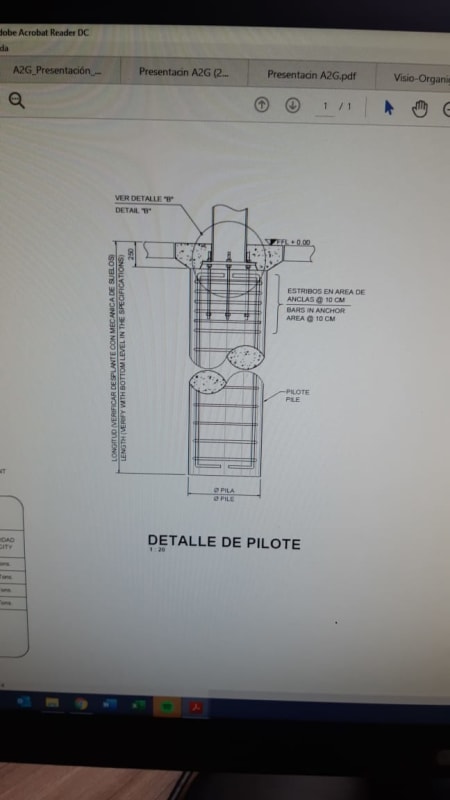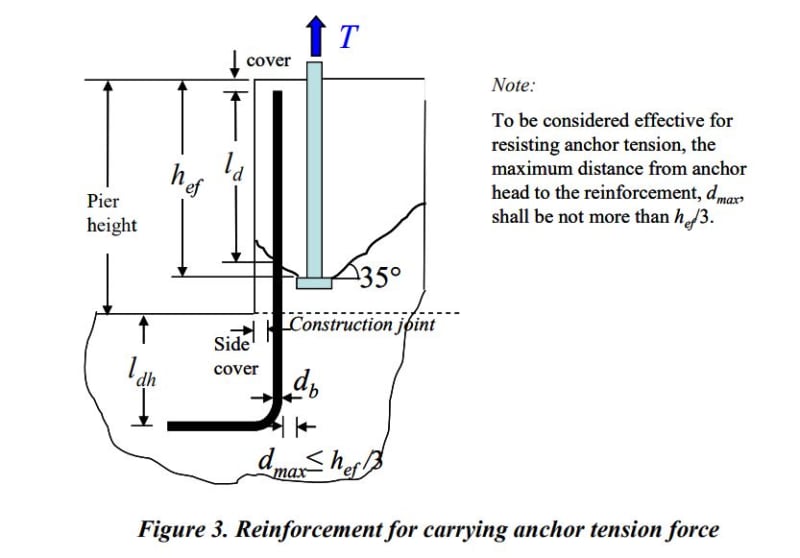Navigation
Install the app
How to install the app on iOS
Follow along with the video below to see how to install our site as a web app on your home screen.
Note: This feature may not be available in some browsers.
More options
Style variation
-
Congratulations cowski on being selected by the Eng-Tips community for having the most helpful posts in the forums last week. Way to Go!
You are using an out of date browser. It may not display this or other websites correctly.
You should upgrade or use an alternative browser.
You should upgrade or use an alternative browser.
Hooks at drilled pier shaft reinforcement ends
- Thread starter AValdes
- Start date
- Status
- Not open for further replies.
That depends on what loads you are transferring. And what is sitting on the pier. If it's a structural slab, then I would hook them just because a straight embedment is not enough to do anything. If it's a tall beam or pilaster or column, then straight embedment may be enough.
- Thread starter
- #8

The pile works as a foundation for a metal column (the building is a warehouse). As you can see, 90° hooks are required on top and bottom. I am sure that on the bottom are just pointless.
My understanding of Chapter 17 of 318 suggests me that those hooks on top will not help reinforcing a breakout cone. (Of course I might be wrong).
As you guys are watching this thread, any comments on the ties @ 4” for the anchor length?
Thank you very much everyone!
1) There is no code requirement to hook the bars at the top that I know of.
2) Whether or not hooking the bars is necessary for anchorage depends on the anchorage design approach that you choose to use. There are several possible methods including ACI anchorage, AISC Design Guide on Base Plates and Anchor Bolts, and Widianto (below).
3) Where possible, I prefer to get the anchorage done without the use of hooks. I feel that they add congesting in a situation where it is unwelcome.
4) Your ties at 4" oc are also a function of your anchorage design and design methodology. If you need 'em you need 'em. It's not a bad practice at all.

2) Whether or not hooking the bars is necessary for anchorage depends on the anchorage design approach that you choose to use. There are several possible methods including ACI anchorage, AISC Design Guide on Base Plates and Anchor Bolts, and Widianto (below).
3) Where possible, I prefer to get the anchorage done without the use of hooks. I feel that they add congesting in a situation where it is unwelcome.
4) Your ties at 4" oc are also a function of your anchorage design and design methodology. If you need 'em you need 'em. It's not a bad practice at all.

EZBuilding
Structural
Providing adequate development of the reinforcement in relationship to the loads you are transferring could lead to hooks at top or bottom.
If you have are utilizing skin friction for tension resistance and have narrowed your capacity down to the last feet or so, I would recommend that you have enough developed reinforcement at the bottom sections to transfer those loads.
If you have are utilizing skin friction for tension resistance and have narrowed your capacity down to the last feet or so, I would recommend that you have enough developed reinforcement at the bottom sections to transfer those loads.
Yes, the details appear correct. The hooks at the bottom though are not needed for engineering reasons but may prove useful for tying their spacer blocks off on when they are setting their rebar cage. You definitely want the hooks at the top. Since the steel structure has force continuity into the foundation you will need to develop your vertical reinforcing steel in a short distance (i.e. from top of shaft to bottom of anchor bolts) and the hooks reduce this distance. The tighter spiral/tie spacing at the top is because some codes allow you to take a further reduction on your rebar development lengths if you surround them with closed ties at no greater than 4" spacing. I know AASHTO does. Not sure about ACI or Eurocode. The tighter spiral/tie spacing at the top will also theoretically increase the anchor bolt breakout, however, I don't think ACI recognizes it per that configuration.
slickdeals
Structural
Contractors would prefer it turned in for easier shipping. Sometimes, they like to lap loose dowels in the field. A lot of contractors we're working with these days prefer to use buttonhead terminators.
slickdeals said:Contractors would prefer it turned in for easier shipping.
How do you mean? Do they pick the cages up by the hooks? Or do you just mean that hooks in are better than hooks out for stacking on truck beds etc?
EZBuilding
Structural
Hooks turned in also allows for the removal of temporary casings.
slickdeals
Structural
@Kootk - yes, from stacking on truck beds view point. Again, applicable not to 24" and 18" diameter piles but to larger piles where turned in hooks don't conflict with each other unless you start to stagger hooks.
There is no pile cap and from the looks of the detail there is intent that the base plate be a moment connection. This seems to indicate hooks turned in.
What sometimes gets missed is that the detail is in 2D, drawn without regard to bar sizes. If you have a lot of flexure, the bars can get quite big. Big bars require big hooks - they don't form a nice 90 degree angles like those cartooned on the detail, and they have long tails.
It's best to lay out the hooks to scale in plan to see if they fit without a lot of overlapping. I specified some big hooked bars in the top of a drilled pier once (#10s, I think) and I grossly underestimated the real hook radius and tail length. Not pretty.
Sometimes 180 degree hooks lay out better. Sometimes proprietary terminators are better.
And the hooks at the bottom seem totally unnecessary to me.
What sometimes gets missed is that the detail is in 2D, drawn without regard to bar sizes. If you have a lot of flexure, the bars can get quite big. Big bars require big hooks - they don't form a nice 90 degree angles like those cartooned on the detail, and they have long tails.
It's best to lay out the hooks to scale in plan to see if they fit without a lot of overlapping. I specified some big hooked bars in the top of a drilled pier once (#10s, I think) and I grossly underestimated the real hook radius and tail length. Not pretty.
Sometimes 180 degree hooks lay out better. Sometimes proprietary terminators are better.
And the hooks at the bottom seem totally unnecessary to me.
In all my time, I've never seen hooks (or cogs) on vertical bars in a bored pile. They would be useless at the bottom, and could cause problems of congestion and plastic settlement cracking at the top. Much better to provide supplementary reinforcement if needed for development at the top.
- Thread starter
- #20
Thank you very much, everyone! I appreciate a lot every single reply.
At the end, the guy who designed the piles argued that those hooks “help confine the concrete” …whatever that means. He didn’t argue about tearout, development length, etc. The thing is that those hooks are just long enough to require spliced bars, when without them, single bars would have worked for the whole pile length.
Thanks again everyone for your help, I really appreciate it. I have been reading this website for a couple of years now, but this is my first question. I am amazed by the amount of specialized knowledge and the cooperative spirit of everyone here.
Thanks!
At the end, the guy who designed the piles argued that those hooks “help confine the concrete” …whatever that means. He didn’t argue about tearout, development length, etc. The thing is that those hooks are just long enough to require spliced bars, when without them, single bars would have worked for the whole pile length.
Thanks again everyone for your help, I really appreciate it. I have been reading this website for a couple of years now, but this is my first question. I am amazed by the amount of specialized knowledge and the cooperative spirit of everyone here.
Thanks!
- Status
- Not open for further replies.
Similar threads
- Locked
- Question
- Replies
- 1
- Views
- 1K
- Replies
- 15
- Views
- 7K
- Replies
- 4
- Views
- 1K
- Replies
- 5
- Views
- 1K
- Locked
- Question
- Replies
- 10
- Views
- 10K
